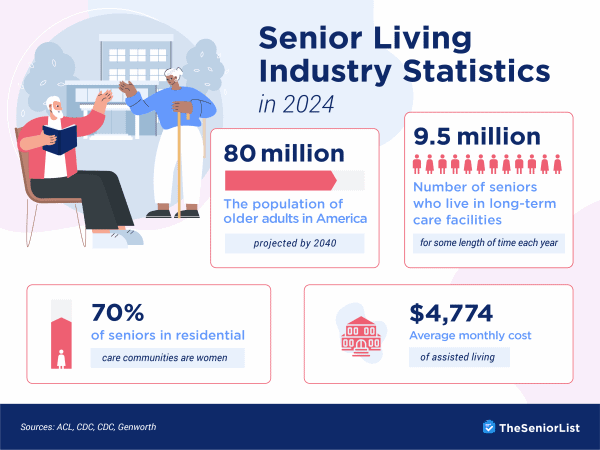Senior Living Industry Statistics in 2025

As the population ages, the demand for long-term care increases. According to the Administration for Community Living (ACL), the number of seniors in the United States is expected to grow to 80 million by 2040. This projection likely contributes to the rapidly growing market caps for the senior living industry, which includes assisted living facilities, nursing homes, and communities that house older adults.
This article will review some of the key statistics related to the senior living industry, including the size of the market, its trends, and the demographics of residents. The article will also provide some insights into the future of the senior living industry.
FYI: Did you know that Medicare doesn’t cover most long-term care?
Types of Senior Living Communities
Senior living communities come in a variety of forms and cater to a wide range of needs. We can break them down based on the level of care (both custodial and medical) provided to residents.
The most common types of senior living communities include:
- Senior apartments: Senior apartments, often called 55+ apartments, are like any other type of apartment complex; however, only older adults are allowed to live in them. These communities often offer plenty of shared amenities, but provide little in terms of care services.
- Independent living: Similar to senior apartments, independent living communities usually offer little in terms of care services (hence the name); however, they usually have more robust amenities, events, and other activities for residents.
- Assisted living: Assisted living communities provide residents assistance with activities of daily living (ADLs) such as bathing, dressing, and eating. They also typically offer amenities such as meals, transportation, and social activities.
- Memory care: Memory care communities are nearly identical to assisted living communities; however, they specialize in supporting residents with Alzheimer’s and other forms of dementia.
- Nursing homes (skilled nursing facilities): Unlike other types of living arrangements, nursing homes provide round-the-clock medical care to residents.
- CCRCs: Continuing care retirement communities (CCRCs) offer a continuum of care, from independent living to assisted living and skilled nursing care. This means that residents can move between levels of care as their needs change.
Statistics on the Senior Living Industry
- By 2060, the senior population is projected to exceed 95 million.
- Over 9.5 million seniors in the U.S. live, for some period, in long-term care and post-acute care facilities each year.
- Today, there are roughly 30,600 assisted living communities, with a total of 1.2 million licensed beds in the United States.
- There are approximately 15,600 nursing homes in the United States.
- The compound growth rate of the assisted living market is projected to grow by 5.53 percent annually through 2030.
- The occupancy rate for assisted living facilities has gone up 7.3 percentage points in 2023 alone.
- Welltower has the highest market cap of all senior housing providers in the U.S. at $18.8 billion, followed by Healthpeak Properties and Ventas.
Costs
- Over 81 percent of residential care communities are for-profit organizations.
- The national average cost of assisted living facility care in 2023 is $4,774 per month.
- The national average cost of nursing home care in 2023 is $8,390 per month for a semiprivate room and $9,584 per month for a private room.
- Homemaker or home health aide services cost an average of $5,259 to $5,462 per month in 2023.
- By 2031, the national average cost of assisted living care is projected to be $6,048 per month.
- By 2031, nursing home care is projected to cost between $10,628 to $12,141 per month.
Demographics
- Nearly half of all residents of care facilities are over the age of 85.
- 41.3 percent of residents of assisted living facilities have Alzheimer’s or dementia.
- Around 70 percent of seniors staying in residential care communities are female.
- Male nursing home residents report significantly lower quality of life and satisfaction scores than female residents.
- According to the National Center for Health Statistics, 38.6 percent of nursing home residents are older than 85, 26.7 percent are between 75 and 84, 18.2 percent are between 65 and 74, and 16.5 percent are under 65.
Types of Communities
- The senior living industry market value has grown to $94.2 billion as of early 2023.
- As of 2022, over 1.157 million people reside in nursing homes, up from 2021 but down from the seven-year high of 1.367 million in 2015.
- Around 818,800 seniors stay in residential care communities.
- There are nearly 1.2 million licensed beds in over 30,000 assisted living communities in the U.S., with an average of 39 beds per community.
- Only 18.2 percent of assisted living communities have care units or floors designated for dementia care.
- 37 percent of assisted living communities reported operating at a financial loss in 2022.
The Caregivers
- 63 percent of assisted living communities are moderately to highly understaffed.
- An increase of 1 point on the 100-point employee satisfaction score for nursing home employees can result in a 19 percent reduction in resident falls.
- 40 percent of nursing home administrators leave their jobs each year due to dissatisfaction.
- Less than 30 percent of senior living organizations retain over 80 percent of their new full-time staff members after a month of employment.
The Future of Senior Living
Reports suggest that the senior living industry will grow by nearly $100 billion by 2027 due to the baby boomer population reaching retirement age. The senior population increased by 38.6 percent from 2010 to 2020, its fastest rate of growth in over a century.
What this means for seniors in 2023 and beyond is a rising demand for rooms and employees within the senior living industry, as well as more stringent community requirements and more expensive services. Choosing the right living arrangement for your situation has never been more important for the financial and emotional security of you and your loved ones.
